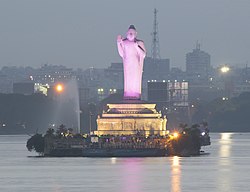This article needs additional citations for verification .(December 2022) |
This article is written like a travel guide .(June 2023) |


Hyderabad is the capital and largest city of the South Indian state of Telangana. It was ruled by the Qutub Shahis, Mughals and the Nizams which shaped its history. The city is noted for its monuments which includes the masterpiece of Charminar and the fort of Golconda. There are a multitude of masjids, temples, churches and bazaars in the city.
Contents
- Historical monuments
- Palaces
- Religious places
- Museums and planetarium
- Lakes of Hyderabad
- Parks and gardens
- Shopping Malls and modern places
- Others
- Tourism of Telangana
- Outline of tourism in India
- References
- External links
The tourism industry forms an important role in the economy of Hyderabad. Tourism-related fairs are held regularly, [1] and in 2010, the city was listed among the Beta- World City by the global city index produced by GaWC, [2] and in 2011 the city was rated 19th in the world by The New York Times in The list of 41 Places to Go in 2011. [3] As of 2011, the tourism promotion budget for the city was increased to ₹ 520 million. Telangana, which is India's top domestic tourist destination, receives up to 157 million visits, [4] and reached 1.5 million international tourists, which generated US$23 million in revenue. [4] The city houses famous historical sites including Charminar, UNESCO Asia Pacific Heritage site of the Chowmahalla Palace, [5] Salar Jung Museum (among the world's largest private collection museums) as well as art galleries, libraries, sports complexes, museums and theaters. It is the place of nawabs.
Hyderabad is known as The City of Pearls, as once it was the only global centre for trade of large diamonds, emeralds and natural pearls. [6] Many traditional and historical bazaars are located around the city. [7] [8] The Laad Bazaar situated near Charminar has shops that sell pearls, jewellery [7] and products such as silverware, Nirmal, Kalamkari paintings and artefacts, bidriware, lacquer bangles studded with stones, saris, handwoven materials in silk and cotton. The following is a list of tourist attractions in Hyderabad.




















